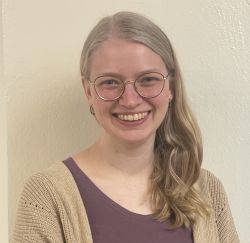|
SAS Graduate Student Award – This award, also known as the Barbara Stull Graduate Student Award, is given to up to 2 graduate students in recognition of outstanding research in the area of spectroscopy. Any full-time student doing research in the field of spectroscopy shall be eligible for the award. The recipient(s) shall be selected by the Awards Committee for approval by the Executive Committee. The award will be presented at the Society’s award ceremony. 2025 Recipients
Julia Danischewski, Rensselaer Polytechnic Institute, Nominated by Jacob T. Shelley During her time in the Shelley Lab, Julia has been excited to work on developing new instrumental techniques for mass spectrometry - in particular by studying the recently discovered acoustic ion manipulation (AIM) phenomenon. Her thesis research aims to characterize the novel behaviors of gas-phase ions in acoustic fields at atmospheric pressure and develop new acoustic-based ion-optic devices. This work has been published in the Journal of the American Chemical Society and Analytical Chemistry, as well as presented at several international conferences. Julia has received numerous awards and fellowships, including the Agilent/ACS Division of Analytical Chemistry Graduate Fellowship and a DAAD Research Fellowship that enabled her to spend a summer at the Bundesanstalt für Materialforschung und -prüfung in Berlin, Germany. She served several years on the executive board of her local student chapter of the Society for Applied Spectroscopy, before recently becoming the national student representative. Julia is excited to continue taking AIM at new targets, and thanks the awards committee for their generous recognition.
Masha Zarei, The University of British Columbia, Nominated by Edward Grant Mahsa co-designed a dual-laser Shifted-Excitation Raman Difference Spectroscopy (SERDS) platform with a common-mode-rejection (CMR) algorithm that slashes fluorescence interference and cuts soil-carbon prediction error by nearly one-third across a 900-sample North American dataset. Adopted by Miraterra Technologies, her pipeline now powers their commercial high-throughput soil-spectroscopy platform and was spotlighted as a cover article in Analytical Chemistry. 2024 Recipient
Piyush Raj, Johns Hopkins University Piyush Raj is a doctoral student working with Prof. Ishan Barman in the Department of Mechanical Engineering at Johns Hopkins University. Prior to joining the Ph.D. program, Piyush obtained his M. Tech in Nanoscience and Engineering from the Indian Institute of Science (IISc) Bangalore, where he was awarded the Institute Medal for academic excellence. He completed his B. Tech in Mechanical Engineering from the Indian Institute of Technology (IIT) Guwahati, followed by a year-long stint as a workshop supervisor at L&T Heavy Engineering. His current research efforts are directed toward improving existing Raman Spectroscopy (RS) techniques for biological applications. His recent work in this area has demonstrated the first realization of an in situ self-assembled Raman probe devoid of a plasmonic NP for targeted Raman imaging of tumors. With spatial offset Raman spectroscopy (SORS), his work has shown the first depth-dependent damage gradation in cartilage in a non-destructive manner. Alongside his efforts to improve RS, Piyush has also worked on standardizing optical phantoms for Raman spectroscopy, where he developed a layered skin-mimetic phantom designed to replicate critical features of human skin. Additionally, he developed a new approach to perform quantitative measurements with surface-enhanced Raman spectroscopy (SERS) for clinical applications with limited measurement data by integrating outlier detection in an unsupervised manner. Overall, his research efforts have resulted in 20 peer-reviewed publications in journals such as Angewandte Chemie, Advanced Science, Biosensors and Bioelectronics, Small and Nano Letters, including a cover article in Angewandte Chemie and Advanced Science. |




